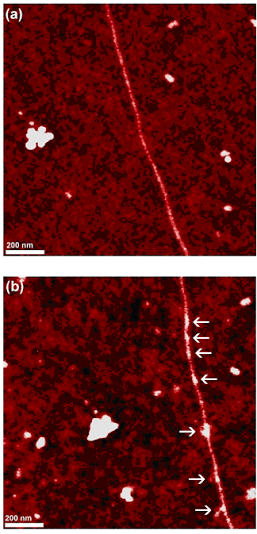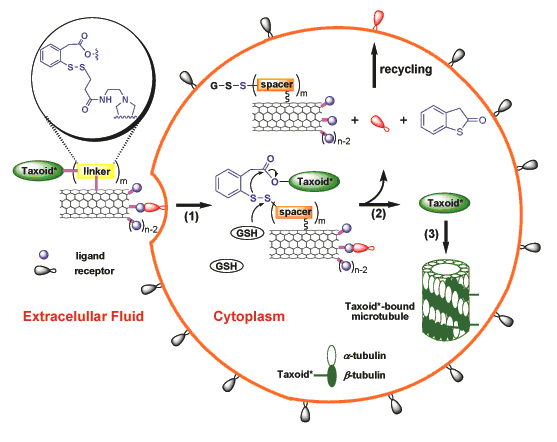Biological Systems
1. Ligand-receptor-protein system covalently bound to oxidized SWNTs as a model proof-of-concept for employing such SWNTs as biosensors. All data (including current-voltage measurements) showed that both Knob and CAR proteins immobilized on SWNT surfaces fully retained their biological activities, suggesting that SWNT-CAR complexes can serve as biosensors for detecting environmental adenoviruses.
Ref.: Nano Letters, v.7, 3086 (2007).

2. Development of a novel SWNT-based tumor-targeted drug delivery system (DDS), consisting of a functionalized SWNT linked to tumor-targeting modules as well as prodrug modules. There are three key features of this nanoscale DDS: (a) use of functionalized SWNTs as a biocompatible platform for the delivery of therapeutic drugs or diagnostics, (b) conjugation of prodrug modules of an anticancer agent (taxoid with a cleavable linker) that is activated to its cytotoxic form inside the tumor cells upon internalization and in situ drug release, and (c) attachment of tumor-recognition modules (biotin and a spacer) to the nanotube surface. To prove the efficacy of this DDS, three fluorescent and fluorogenic molecular probes were designed, synthesized, characterized, and subjected to the analysis of receptor-mediated endocytosis and drug release inside the cancer cells (e.g. L1210FR leukemia cell line) by means of confocal fluorescence microscopy. The specificity and cytotoxicity of the conjugate were also assessed and compared with L1210 and human non-cancerous cell lines. It was unambiguously proven that this tumor-targeting DDS works exactly as designed and shows high potency towards specific cancer cell lines, thereby forming a solid foundation for further development.
Ref.: J. Am. Chem. Soc., v.130, 16778 (2008).

